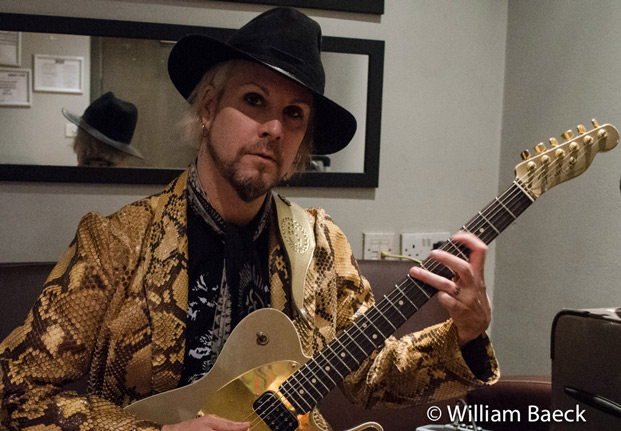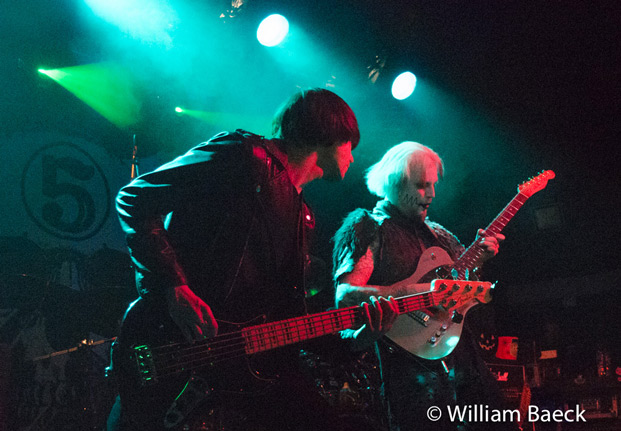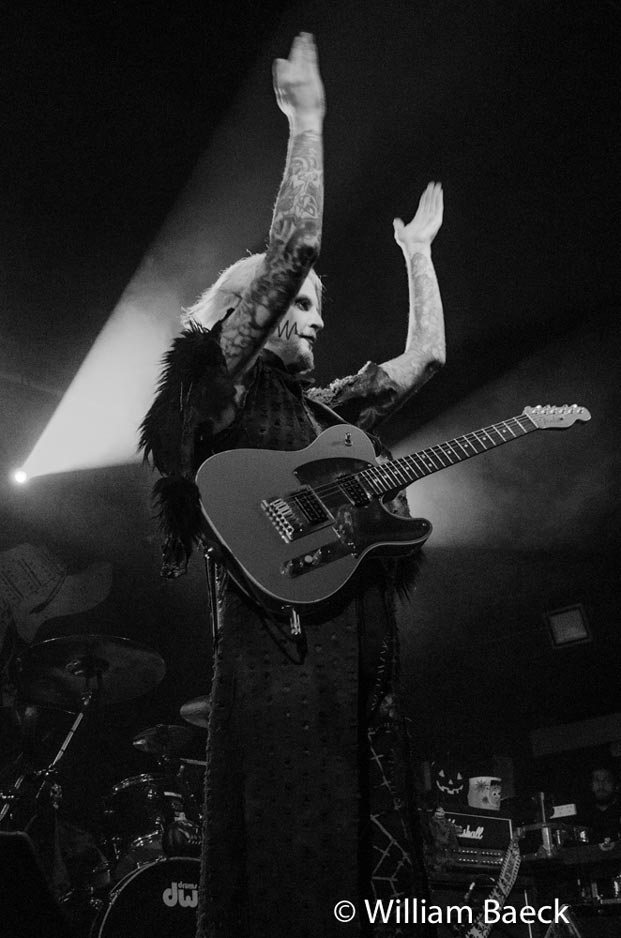John 5 Talks Playing Guitar at Home

Don’t try to pin down John 5’s style with a one-word label. A passionate metal guitarist, he’s also adept at bluegrass, country, jazz, western swing and flamenco.
It’s a wide musical embrace that has enabled him to work with everyone from k.d. lang to Rob Zombie. In doing so, John 5 has created genre-morphing shred that pushes through the bounds of normal guitar playing. Thank goodness.
Let’s focus on your instrument choices for home use. Because that's what you and every guitarist have in common: at some point, you're all playing at home.
Yeah, exactly. You know, it's funny, because I really enjoy being at home and recording and doing all that. But then when I have too much time doing that, I really enjoy touring.
I don’t expect you’re playing a JCM 900 in the bedroom, though.
Here’s the kind of saying or joke about me, is that I’ll play through anything. Look: [holds up a battery-powered, Marshall micro amp], I’ll play through anything, it doesn’t matter. At home I have an amp in every room and it doesn’t matter which one. I think I have a little Fender Harvard in one room, and I have a Marshall in another, and I have a Princeton in one room, and then I have a Marshall in the other room.
It doesn’t really matter what I’m playing through, as long as there’s sound then I can play. So any room I am in, I’ll just plug in and play, because I always walk around with my guitar. But it’s kinda just whatever is in that room at the time.
When you go into a guitar shop, what sort of thing are you looking for?
I like condition. Of course, I love old vintage Teles. And my whole thing is getting one from every year, starting in 1950.
Is your 1950 Fender Broadcaster still the holy grail for you?
By far. That’s such a gorgeous, gorgeous instrument. […] I love history and it was the beginning of it all. It was the first solid body electric guitar and it was Fender where it all started—and that was number one. And then number two was condition and the condition was just unbelievable. And it weighs nothing, it’s the lightest guitar I own, it’s unbelievable. So I mean it’s just the perfect guitar.
Get The Pick Newsletter
All the latest guitar news, interviews, lessons, reviews, deals and more, direct to your inbox!
Norm Harris [at Norman's Rare Guitars in Tarzana, California] is your go-to person for a lot of this?
Yes, he is my guy. And, believe it or not, Guitar Center in Hollywood is incredible. Those two places are amazing. It’s funny, there’s so many vintage guitar shops in California. It’s unbelievable, and because of the weather there, there’s not a lot of checking compared to guitars from New York or something like that, or overseas.
So you can tell if they’re California guitars.
You know, Fender is California. So that’s where I get a lot. But sometimes you see them and they’ll be checked and you’ll go, “This one left its home.”
Do you feel you’re in a caretaker role once you have something like that?
Of course. It’s a great investment. And it’s tough because it’s such a great investment that not only musicians are buying these guitars, there’s investors and people that play the stock market. They are like, “Well, guitars are a very hot commodity and there’s not gonna be another one of these,” and they go up in value so much that a lot of people just buy guitars because it’s such a great investment.

How do you feel about non-musicians buying vintage guitars? It seems sad to just hang it on a wall.
It’s just how it is. I think I feel OK about it. You don’t have to be a painter to buy a painting. I mean it’s a great investment and I understand it. So I can’t be like, “You can’t buy this.” If you have the smarts and the money, go for it.
So when you’re choosing something do you tend to go for lightweight yourself?
I go for originality and condition. If I find a Maui Blue International Color 1978 and it’s beautiful and original but it weighs a ton, I’ll still buy it. But if it’s super light—which none of those guitars are—even if it’s light, if the condition of it is not original I will not buy it.
Would you modify it?
Nope, just change the strings. The only thing different on my guitars is the strings.

When you buy something new is there a difference in what you're looking for?
My vintage guitars, I'll treat them like little pieces of gold, and I'm conscious that I cherish them—you know, put them in the right air conditioning, and the right temperature, and all that stuff. But I’ll tour with these [new] guys. And I have very special guitars. I have a lava lamp one, and one with all these LED lights, and then I've got a stained glass guitar, and they're all Telecasters. But I make them very special. I even have one which has this big iPad in it. So it’s a lot of fun; people enjoy it.
The vintage ones are mainly the ones you’re playing at home? Or are you playing with a mix of new versus old?
It's a little bit of both. If I'm missing my vintage guys I'll pull them out.
Are there some years that appeal to you less?
I'm back and forth on the Seventies ones, though I love the Fender Telecaster Deluxe: two humbuckers and they have the toggle switch up here, but they have that really cool pickguard. And the incredible Telecaster Custom. Not the three-color one, not the sunburst guy with the double binding. But like a cool Keith Richards one with the humbucker at the neck.
Lastly, it seems like you can draw a line from Roy Clark’s mix of genres to Danny Gatton’s redneck jazz, to your shred and the way you shift styles within songs.
Yeah, you have so many: western swing jazz, or you have the old country thing—you can add the shred stuff or whatever. You can have the Jerry Reed, any of that. It's all great on the Tele. …But then here I was playing this heavy, heavy music because it's a great guitar. It’s not just a country guitar, it’s a great guitar.

William Baeck is a writer, photographer and hack guitarist living in London. You can check out his webpage at williambaeck.com and reach him on Facebook andTwitter.
“I just learned them from the records. I don’t read tabs or anything, I don’t read music – I learned by ear”: How a teenage Muireann Bradley put a cover of Blind Blake’s Police Dog Blues on YouTube and became a standard bearer for country blues
“The Strat was about as ‘out’ as you could get. If you didn’t have a Floyd Rose, it was like, ‘what are you doing?’”: In the eye of the Superstrat hurricane, Yngwie Malmsteen stayed true to the original










